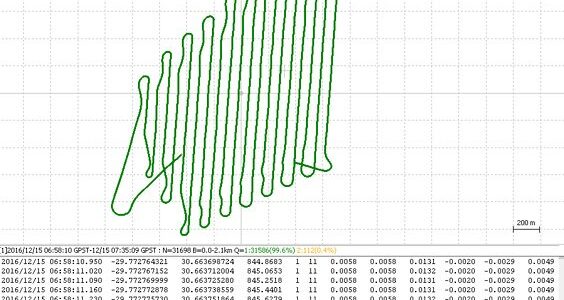Reach calculates real-time coordinates with centimeter accuracy
and streams them in NMEA or binary format to your device
over UART, Bluetooth or Wi-Fi
RTK positioning for navigation
PPK for UAV mapping.
Centimeter accuracy without GCP
Reach module logs precise tracks and the exact moment when each photo is taken
Why camera synchronization is so important?
Usually autopilot triggers the camera and records the coordinate it has at the moment. When the drone is flying at 20m/s and GPS works at 5Hz, that means your autopilot will have position readings only each 4m. While enough for navigation such readings are not suitable for precise georeferencing. Also, there is always a delay between the trigger and the actual moment the photo is taken.
Reach module solves this by directly connecting to the camera hot shoe port which is synced to the shutter. The time of each photo is logged with a resolution of less than a microsecond.


Connect Reach to a hot shoe port on a camera
Every time a photo is taken camera produces a pulse on a flash hot-shoe connector which is synced to a shutter opening.

Fly a drone, Reach will record photo events
Reach captures flash sync pulses with sub-microsecond resolution and stores them in a raw data RINEX log in internal memory.

Download logs from Reach and base station
After the flight get the RINEX logs from your airborne Reach module and a base station (Reach RS, CORS or other receiver).

Process logs and get a file with geotags of photos
Process RINEX files using the free RTKLIB software. Produced file with precise coordinates of the photos can be used for georeferencing.
Reach in action
3DroneMapping completes PPK trials with the average zero mean error in all axes
Luke Wijnberg, 3DroneMapping
As a brief synopsis of the results, the maximum deviation of points was no more than 0.09m in all axis. This is an incredible result given the fact that the average pixel size of the resulting imagery was 0.045m. It is interesting to note that the average mean error in all axes is 0.00m!

Tuffwing gets 4cm precision without GCPs with Emlid Reach RTK
Brian Christal, Tuffwing
Tuffwing recently performed integration of Emlid Reach RTK to enable making precision maps without use of GCPs. The system was benchmarked by comparing direct georeferenced model with a set of GCPs, used solely for error detection purposes. Achieved lateral RMS error is just 4cm according to the Pix4D quality report.

Event38 integrates Emlid Reach and starts providing ready-to-go PPK mapping solution
Jeff Taylor, Event38
In this case study, we produced an orthomosaic in the Drone Data Management System™ with 2.45cm horizontal and 5.08cm vertical RMSE, as compared with a survey-grade GPS on the ground.

ReachView app

Helps you with setup
Easily configure correction input, solution output, update rate and satellite systems in use. Manage Wi-Fi and Bluetooth connections.
Improves and updates
When connected to the Internet it will automatically check if the new version is available and show you a notification. Simply tap the update button to receive new features and advancements.
Simple log management
Logs are automatically recorded in internal memory. View a list of the logs and download them using the ReachView app.
Provides monitoring data
ReachView shows current satellite signal strength, constellation visibility forecast, your location on a map and much more.
Specifications
Mechanical
- Size: 56,4 x 45,3 x 14,6 mm
- Weight: 20 g
- Operating tº: -20…+65ºC
Electrical
- Input voltage on USB and JST GH connectors: 4.75 – 5.5 V
- Antenna DC bias: 3.3 V
- Average current consumption @5V: 200 mA
Data
- Internal storage: 8 GB
- Correction input: RTCM2, RTCM3
- Solution input: ERB, plain text, NMEA (RMC, GGA, GSA, GSV)
- Logs: RINEX2.X, RINEX3.X
GNSS
- Signals: GPS/QZSS L1, GLONASS G1, BeiDou B1, Galileo E1, SBAS
- Tracking channels: 72
- IMU: 9DOF
- Update rate: 14 Hz / 5 Hz
Connectivity
- Wireless: Wi-Fi (802.11b/g/n), Bluetooth (4.0/2.1 EDR)
- Interfaces: USB, UART, Event
Positioning
- Static:H: 5mm + 1ppm, V: 10mm + 2ppm
- Kinematic:H: 7mm + 1ppm, V: 14mm + 2ppm

